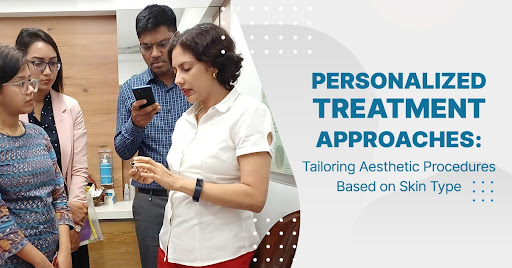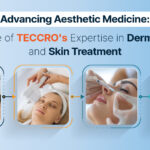- info@teccro.org
- Mumbai, India
- Contact Us
04Jan
Personalized Treatment Approaches: Tailoring Aesthetic Procedures Based on Skin Type
by admin, 0 Comments

Customized treatments according to skin type are indispensable in dermatology and aesthetic medicine for achieving superior results without risks. With the different responses of skin to various procedures or treatments, the skin type serves as a vital guide in determining the most effective treatment. A systematic approach to treatment in general can help health practitioners tailor effective and safe treatments in improved patient outcomes.
Understanding Skin Types
It is mostly based on the oil production, sensitivity, hydration, or the presence of skin conditions such as acne or pigmentation that skin types are usually categorized. Popularly known as Fitzpatricks Skin Type, one of the well-known systems of skin classification categorizes skin into six types starting from Type I, which is very fair, up to Type VI, which is very dark. This classification helps in predicting the behavior of the skin when exposed to treatments like lasers, chemical peels, or microneedling. A list of clinical research organizations in India plays a crucial role in studying how different skin types react to such treatments, contributing to safer and more effective procedures tailored to each individual’s skin.
Most of them are dependent on oil production, sensitivity, hydration, and the presence of any potential conditions such as acne or some discolorations. Principally, Fitzpatricks skin types: it is one of the popular systems of skin classification among the six types of skin ranging from Type I, which is very fair, to Type VI, which is very dark. This classification is helpful to predict the response of the skin to various treatments such as lasers, chemical peeling, and microneedles.
Assessment of skin
An extensive skin assessment is important in commencing any form of treatment. This includes evaluating the patient’s skin type, tone, and texture, as well as identifying lumps or lesions like acne, pigmentation, or rosacea. Knowing these factors helps in determining the most suitable medical treatment modality, as some treatments may not be suitable for certain skin types. For instance, hyperpigmentation from some laser treatments may be more prevalent in individuals with darker skin tones, and alternatives or changes in settings can be explored. The best clinical research institute in Mumbai plays a vital role in advancing research on skin treatments, providing valuable insights into how different skin types respond to various procedures, and ensuring that personalized care is delivered effectively and safely.
Selection of Treatment Based On Skin Type
This is followed by selection of treatments according to their most appropriate application based on skin type. For example:
Oily or Acne-Prone Skin (Fitzpatrick Type IV-VI): Oily and acne-prone skin can benefit from chemical peels, microneedling, and light-based therapies, such as IPL (intense pulsed light). These treatments help with oil management, scars, and skin texture improvement.
Dry or Sensitive Skin (Fitzpatrick Type I-III): Hydrating treatments like mild chemical peels, hydrafacials, and microneedling focus on collagen stimulation would be best for a patient with dry or sensitive skin. Hydrating patients, therefore, improves the skin’s hydration and texture without irritation.
Hyperpigmentation or Sun Damage (Fitzpatrick Type II-IV): Fractional laser, chemical peels, and topical lightening agents are among the treatments available to persons suffering pigmentation conditions or having sun damage. Do you help with skin tone balancing and clearing dark patches?
Upon selecting a modality of treatment, the plan needs to be customized, as parameter settings for the suggested modality vary according to the patient’s skin type or condition, as well as the intensity, frequency, and length of exposure. For example, a patient with sensitive skin may be subjected to a lesser intensity of laser treatment or longer intervals between sessions. Clinical research companies in Mumbai play a crucial role in studying the effects of different treatment parameters on various skin types, providing essential data that helps healthcare professionals tailor treatments for optimal results while minimizing potential risks.
Post Treatment Management
Post-care should be part of the algorithm, as it ensures that the skin heals properly and reduces side effects. For example, laser-treated patients with dark skin usually need intensive sun protection and topical soothing treatments to avert pigmentation changes.
Dermatologists and aesthetic professionals can provide customized yet safe and effective treatments by tailoring their therapy to a person’s skin type. A structured algorithm ensures that each patient receives the best possible treatment for their unique skin characteristics, with benefits both short-term in terms of treatment results, and long-term in skin health. Clinical research organizations in Pune play a vital role in advancing these treatment protocols, offering evidence-based insights to guide professionals in delivering optimal care tailored to individual skin needs.
Related posts:
 The Art of Dialogue: Enhancing Researcher-Participant Communication
The Art of Dialogue: Enhancing Researcher-Participant Communication
 Beauty Beyond Borders: Redefining Aesthetic Excellence Through Cultural Harmony
Beauty Beyond Borders: Redefining Aesthetic Excellence Through Cultural Harmony
 Understanding the Challenges of Patient Recruitment for CROs
Understanding the Challenges of Patient Recruitment for CROs
 The Role of FDA-Approved Technologies in Clinical Trials
The Role of FDA-Approved Technologies in Clinical Trials
 Advancing Aesthetic Medicine: The Role of TECCRO’s Expertise in Dermatology and Skin Treatment
Advancing Aesthetic Medicine: The Role of TECCRO’s Expertise in Dermatology and Skin Treatment
 The Surge of Non-Surgical Aesthetic Treatments in Today’s Era
The Surge of Non-Surgical Aesthetic Treatments in Today’s Era
 Empowering Investigators: TECCRO’s Commitment to Ethical & Compliant Clinical Research
Empowering Investigators: TECCRO’s Commitment to Ethical & Compliant Clinical Research
 Overcoming Ethical Dilemmas in Aesthetic and Dermatological Research
Overcoming Ethical Dilemmas in Aesthetic and Dermatological Research
Search
Recent Posts
- Challenges in Placebo Design for Aesthetic and Hair Loss Studies
- Long-Term Safety Outcomes in Fillers: What Do Clinical Studies Show?
- Cultural Perceptions of Beauty and Their Impact on Trial Recruitment
- The Rise of Investigator-Initiated Trials in Aesthetic Dermatology
- Recruitment Challenges in Aesthetic Clinical Trials and How to Overcome Them
About TECCRO

We at The Esthetic Clinics Clinical Research Organization (TECCRO) believe that Clinical Research Organizations (CRO) necessarily need to have the best clinicians so that the pharmaceutical sponsors can be guided strongly on what would be the best way to carry their study protocols forwards, to achieve their means. In this sense, our clinical team provides a clear & immense differentiator and that is we The Esthetic Clinics Clinical Research Organization (TECCRO) is consistently rated amongst the Best Clinical Research Organizations in India by industry and pharmaceutical companies. Read more..
